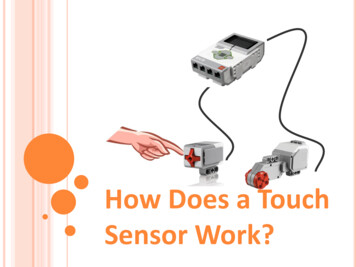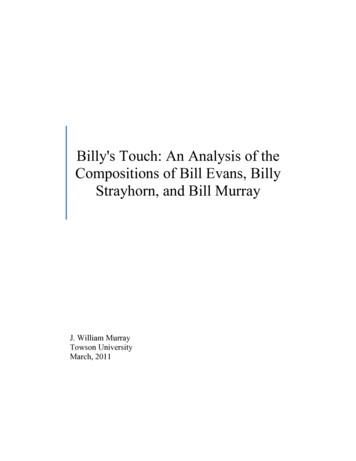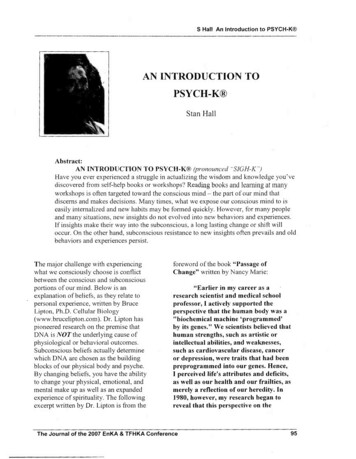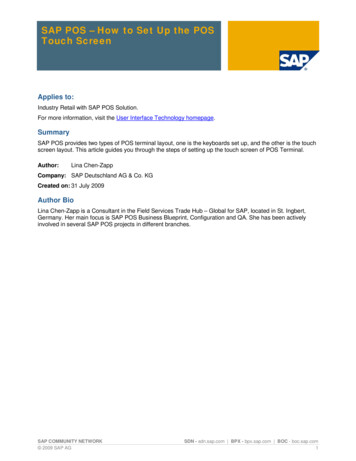
Transcription
How Does a TouchSensor Work?
Touch Sensors Pre-Quiz1.Where on our bodies do we have touch sensors?2.Provide an example of “stimulus-sensorcoordinator-effector-response” framework usingthe human touch sensor.3.When you press the LEGO touch sensor, whatexactly happens and how does it convey thesignal to the LEGO brick?4.Give examples of sensors in engineering systemsthat are similar to the human touch sensor.2
Touch Sensors Pre-Quiz Answers1.Where on our bodies do we have touch sensors?We have touch (or tactile) sensors on our skin all over our bodiessince we feel the sense of touch everywhere.2.Provide an example �framework using the human touch sensor.Hot object touch it using a finger nervous system muscle movefinger back3.When you press the LEGO touch sensor, what exactly happens andhow does it convey the signal to the LEGO brick?When the touch sensor button is pressed, it closes a circuit (similar towhen you turn on a switch) and sends a current to the LEGO brick,which then knows that the touch sensor button was pressed.4.Give examples of sensors in engineering systems that are similar tothe human touch sensor.Examples: LEGO touch sensor, sensors in the gripper of a robot3
Review: What is a Sensor?A sensor is a device that measures a physical quantity. For example, whenyou touch an object, sensors on your fingers send signals to your brain sothat it recognizes it as being hot or cold. The skin on your fingers containsmillions of sensitive nerve endingsthat can detect stimuli such astemperature. This stimulus isconverted to neuronal impulses thatare sent via nerves to a specific regionin the brain, which interprets it asbeing hot or cold.The same happens with other physicalquantities such as pressure and pain.4
Details about the Skin Touch SensorWatch the “How the Body Works: The Sensory Cortex and Touch” video: (1:07 minutes)http://www.youtube.com/watch?v IC3YTJNu0Ec&feature related5
Review: How do you sense something by touch?When you touch something, the senses at the tip of yourfingers send signals to your brain through nerves. These signals travel to the brain through the spinal cord. All signals related to the human body travel through thespinal cord. The spinal cord can be referred to as the“common pathway” for brain signals. The brain processes the signal information and then sends itsdecision back through the same neural “wires” to themuscles in your hand to react appropriately. Example: When you touch a hot object, the nerves carry signal to the brainand the brain decides it is bad for you, and quickly sends back a signal to the6muscles in your hand to withdraw the fingers immediately. This signaltransmission takes place in a fraction of a millisecond.
Review: From Stimulus to Responsestimulus sensor coordinator effector responsetouch pain receptor nervous system muscle movementFrom the sequence of steps above, this is what happenswhen you touch something hot: The stimulus is touch, the sensor is the temperature receptor on yourfinger that senses it and relays it to the nervous system (spinal cord andbrain), which is the coordinator. The coordinator makes the decision of how to react, and then commandsthe hand muscles (the effector) to jerk back quickly. So, we go from stimulus (touch) to response (movement of hand).Do This: Sketch out the stimulus-to-response sequence for how thismight be implemented in a robot. Identify all the components,as in the example listed above.(Answer on slide 17)7
brainReview: How does yourhand jerk back whentouching a hot object?Sensors on your finger takethe information about howhot it is to the spinal cordand brain via nerves.These are all part of yournervous system.digital nerve 8
Review: How does your hand jerk backwhen touching a hot object?Your nervous system decides that it is too hot andorders the muscles of your hand to jerk the finger back.contractbicepsfingermovedback9
Review: Robot Sensors(As stated in an earlier activity,) robot sensors: Gather information from the surroundings and send it tothe computer brick Robot sensors can only be used if the robot’s program asksfor information from them! Similarly, the robot can only act on information from thesensors if its program tells it to do so!How do sensors send signals to the computer brick? The sensors send information through the wires (similar to the nervous10system in a human body) that connect them to the computer brick,which uses the information if its program requires it.
How are touch or tactile sensors made?In engineering, the term “tactile” sensor is also used to refer totouch sensors.Touch sensors are made using light (optical), electricity ormagnetism.The LEGO touch sensor has a button-likeprotrusion. When bumped, it sends anelectrical signal to the computer brick sayingthat it has been touched.How does this sensor work?What happens when the button is pressed?Can you guess?Let’s put all your ideas on the classroom board.11
How do touch sensors work?The LEGO touch sensor works like a light switch in your house. When the button is pressed, an electrical circuit is connectedinside the sensor, sending an electric current to the computer. When the button is released, the circuit is broken and noelectricity flows.The LEGO brick can sense this flow ofelectricity, so it knows if the touchsensor is pressed or released.12
Let’s InvestigateHow does the brick read the signal from the touch sensor? Do This: Attach the sensor to the LEGObrick, as shown below. Use the VIEW command and go to thetouch sensor. The display should show 1 when the sensoris pressed, and 0 when not pressed. So, pressing the button closes the circuitand sends a signal sent to the computer.13
Mini-ActivityBelow is a program that uses the touch sensor to play music.Do this: Program it using your computer and download to the samesetup as in the previous slide, that is, the LEGO brickconnected to the touch sensor (plug the sensor into port 2). Go to the Functions Palette for the music button. Run it andexplain your observations, including a step-by-stepexplanation of how the program works. Bonus: For something more challenging, try to make yourown musical notes (see Context Help).(Answer on slide 18)14
Touch Sensors Post-Quiz1.Where on our bodies do we have touch sensors?2.Provide an example of “stimulus-sensorcoordinator-effector-response” framework usingthe human touch sensor.3.When you press the LEGO touch sensor, whatexactly happens and how does it convey thesignal to the LEGO brick?4.Give examples of sensors in engineering systemsthat are similar to the human touch sensor.15
Touch Sensors Post-Quiz Answers1.Where on our bodies do we have touch sensors?We have touch (or tactile) sensors on our skin all over our bodiessince we feel the sense of touch everywhere.2.Provide an example �framework using the human touch sensor.Hot object touch it using a finger nervous system muscle movefinger back3.When you press the LEGO touch sensor, what exactly happens andhow does it convey the signal to the LEGO brick?When the touch sensor button is pressed, it closes a circuit (similar towhen you turn on a switch) and sends a current to the LEGO brick,which then knows that the touch sensor button was pressed.4.Give examples of sensors in engineering systems that are similar tothe human touch sensor.Examples: LEGO touch sensor, sensors in the gripper of a robot16
Answer for Slide 7 Questionstimulus sensor coordinator effector responseobject in front touch sensor brick-computer motor move back17
Mini-Activity Answer for the Teacher18
Vocabulary sensor: A device that converts one type of signal to another;for instance, the speedometer in a car collects physical dataand calculates and displays the speed the car is moving. stimulus: A thing or event that causes a reaction, such as aspecific functional reaction in an organ or tissue. tactile: Related to touch. transducer: Another term for a sensor (see above).19
Image SourcesSlide 1, 8: pointing finger; source: Microsoft clipart: px?qu pointing finger&ex 1#ai:MC900098047 Slide 1, 10, 11, 12, 13: LEGO device images; source: LEGO MINDSTORMS EV3 User’s GuideSlide 4: nerves in human hand; source: Adam, U.S. National Library of Medicine, National Institutes ofHealth: drome.htmlSlide 5: human brain; source: NIDA for Kids: rain-anatomySlide 8: nervous system diagram; source: 2006 Persian Poet Gal, Wikimedia vous system diagram.pngSlide 9: human nervous system; source: Adam, U.S. National Library of Medicine, National Institutes ofHealth: /8679.htmSlide 9: arm muscles-biceps; source: National Cancer muscular/groups/upper.htmlSlide 9: pointing finger; source: Microsoft clipart: px?qu pointing finger&ex 1#ai:MC900233154 Slide 12: how does a touch sensor work? schematic diagram; source: Carnegie Mellon Robotics cscurriculum/multimedia/howtouch.shtmlSlides 14, 15: Screen capture images by the author. Mini-activity adapted from http://www.compchal.org20
Hot object touch it using a finger nervous system muscle move finger back 3. When you press the LEGO touch sensor, what exactly happens and how does it convey the signal to the LEGO brick? When the touch sensor button is pressed, it closes a circuit (similar to when you turn on a switch) and sends a current to the LEGO brick, which then knows that the touch sensor button was pressed. 4 .











